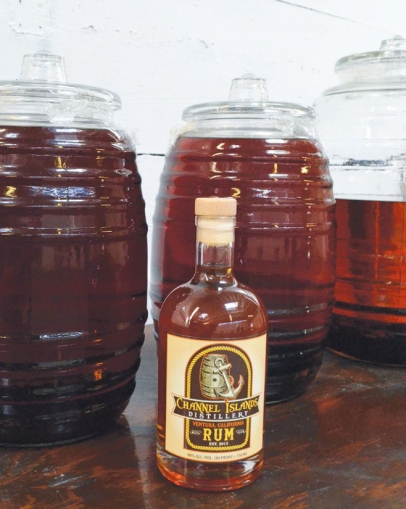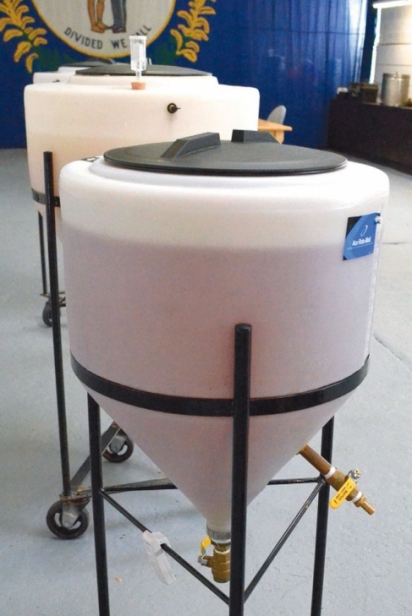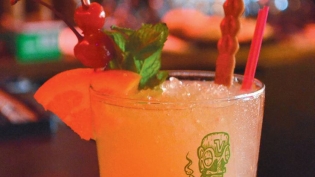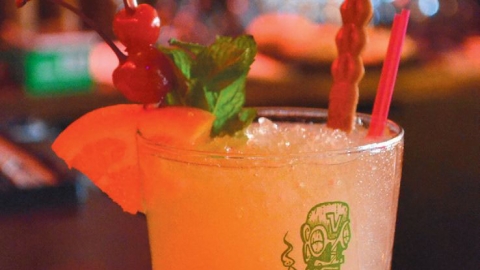Ghost in a Shot Glass: Channel Islands Distillery
Late fall 1926, a Coast Guard ship not far from Santa Cruz Island spotted a fastmoving boat. Suspecting it was carrying contraband and trying to escape, the Coast Guard's officer-in-charge, Boatswain (T) L. H. Williams, signaled for the boat to heave-to. But the Grey Ghost, as she was known, failed to do so. Williams opened fire, and so did crewman Edward O. Calioutte.
The Ghost took multiple crippling shots. She ran aground about one-and-a-half miles east of Valley Anchorage, Santa Cruz Island.
Though the identity of the rum-running boat's operator was lost to history, the Coast Guard reported that they arrested him for violating the Tariff Act of 1922.
Ventura County has a rich tradition of rum-running, as it was known, including a spot not far from Ventura Avenue in Ventura known as "rum row," where bootleggers churned out Prohibition-era booze to sell across the country. Rum runners often landed on the Ventura coast to unload their cargo.
It is here that Michael Machuzak and Joe Freas of Channel Islands Distillery set up shop in a humble industrial space to become modern- day, "legal bootleggers." In the hours away from their day jobs as aquatic toxicologists testing municipal water supplies and performing other environmental analyses, they distill small batches of artisan spirits far beyond the dreams of a backwoods moonshiner.
The two brewed beer and made wine as a hobby for many years before they started distilling. So why did they go the distillery route, and not a winery or brewery?
"To distill you need to make a wash, which is basically a beer or wine, then distill and age – usually for months to years – in barrels," says Freas. "The distilling added another layer to the craft, which intrigued us."
And the still is a thing of beauty, say Freas and Machuzak.
"It is illegal to distill alcohol as a hobby," says Freas, for safety as well as regulatory reasons.
"So when we started to get interested in doing this and knew it wasn't going to be a chemistry experiment anymore, we figured we'd better get the permits and the licenses. But we didn't realize how much was involved."
The federal government regulates distilleries through the Alcohol and Tobacco Tax and Trade Bureau, the state does it through the Department of Alcoholic Beverage Control, and the city follows with business permits, zoning rules and the rest. (The city of Ventura has a police officer dedicated to policing ABC licenses, Freas says.)
It took the pair a year to go through the federal process alone, though they simultaneously worked with state and city officials and had to be fingerprinted, get background checks, provide pay stubs and financial analyses and get character references – not just for themselves, but their wives and family members, too. (By comparison, they say, getting a beer and wine license is a cakewalk.)
It was worth going through the arduous process. "We're pretty confident with the process of what we're doing," says Machuzak. "But we're still learning about the government's process and the regulations." They can sell only brandy directly to retailers; everything else they produce must go through a wholesaler.
Even the labeling process is regulated closely, with requirements about contrasting font sizes and specific information, even image colors. The tax system is also quite Byzantine, as distilled spirits require a federal tax.
CALL IT LEGAL RUM-RUNNING
The onerous regulations proved a true challenge, but obstacles are meant to be hurdled. "We're the first licensed distillery in Ventura County," says Machuzak. "We did a lot of ice-breaking to get here and we weren't going to give up."
The pair authored documents pertaining to fire safety and proper practices that future distilleries will use when applying for licenses in the county. "We had to have still manufacturers meet with building and safety engineers and fire specialists to work on the plan that will now be the rubric for future distilleries," says Freas.
Since no one had filed paperwork to open a distillery before, the partners had to do research, too. It was then that they learned of the Grey Ghost. As a tribute, the ship's name now graces their rum, and the label features the uniquely Ventura County story.
Freas and Machuzak are entrepreneurs working within a wellknown niche, by understanding their market and their community. "We're not borrowing money; it's just Joe and me," says Machuzak. "We're making hand-crafted small batches of quality spirits and we're using local ingredients and working with our community to make it happen."
Their plum brandy is made from local plums. While their 100% certified organic agave spirit uses agave grown in Mexico, it's roasted in Ventura to the founders' specifications.
DISTILLING THE PROCESS
When making "research batches" of rum, Freas pours 50 pounds of brown sugar and molasses into a 30-gallon conical fermenter with yeast nutrient and distiller's yeast and lets it ferment for about a month. (Production runs use a 500-gallon fermenter.)
The sediment (called "trub") falls to the bottom, and what's on top is "clear wash." Depending on the spirit, it can range from 5% alcohol by volume (for whiskeys) to 18% for spirits like vodka.
"We pour that into the still and bring it up to boiling," says Freas. "Once it boils, the first thing to come off is methanol in liquid form and we'll discard that. Once the ethanol begins to pour out, we wait for a nice clean stream of that to pour into our catch vessel, a sixgallon glass container." The distillation takes about six hours, Freas says, and at that point, the rum is about 80% alcohol.
"If we're going to age it, we'll put it into a glass vessel or a barrel and we'll add flavors, spices or oak chips and then add our proprietary dilution water to balance it out." The water they use, Freas says, is water that both he and Machuzak have experimented with to get just the right taste. Being aquatic toxicologists has its advantages.
For the record, Machuzak and Freas say that inexpensive spirits are often the ones that don't take the methanol off the beverage. That's a problem, they say, because methanol in any amount is toxic.
"It's not good for you. It's not just that it's a high percentage of alcohol, it's got toxic ingredients in it and if you consume it over a long period of time, you create problems," Machuzak says. This is one reason why distilling is so highly regulated. So much for that $5 bottle of rum.
Though Channel Islands Distillery is in its infancy, Freas hopes to begin seeing revenue this spring.
"You'll start seeing more of us," Freas says. They have produced many cases of spirits, and they've even applied to have a limited tasting room, which they are hoping will open this spring.
Their rum, agave spirit (called Suave Agave), brandy and whiskey recipes have been finalized and gin is in the works, as is moonshine – a grain-alcohol beverage with flavor more like what you might find in the backwoods.
"We literally have hundreds of ideas we are working on," says Freas.
MOMENT OF TRUTH
Now that I'd learned all about their distillery, Freas and Machuzak treated me to a tasting. (Yes, it's a rough job.)
Grey Ghost rum was up first. It was the smoothest I've ever tasted. Amber in color with proprietary spices and aging, its vanilla character lends it to simple sipping. No Coca-Cola, no soda needed, just the rum. The attention to detail, and the fact that no methanol makes it into the bottle, give this rum a velvety, nutty and sweet flavor that slowly evolves on the palate.
The plum brandy was delicious – and dangerous. It would be glorious poured over pound cake and berries. It would be heavenly as a simple, light aperitif. But its high alcohol and sugar content mean that enjoying too much of it will punish you. A lot. I speak from experience.
The 100% agave spirit was enticing on so many levels, especially to a Southern California resident. Tequila is mother's milk and the basis for most Mexican restaurant bar tabs across the region. Like the rum, though, this sipping tequila is meant to be enjoyed solo or, perhaps, in a quality margarita – not with grocery-store "mix."
The future is here, then. Channel Islands Distillery aims to take the spirits out of the shadows, bring them into the mainstream, into the light – and haunt its patrons in a most delightful manner.
For a list of retailers, visit CIStill.com.








